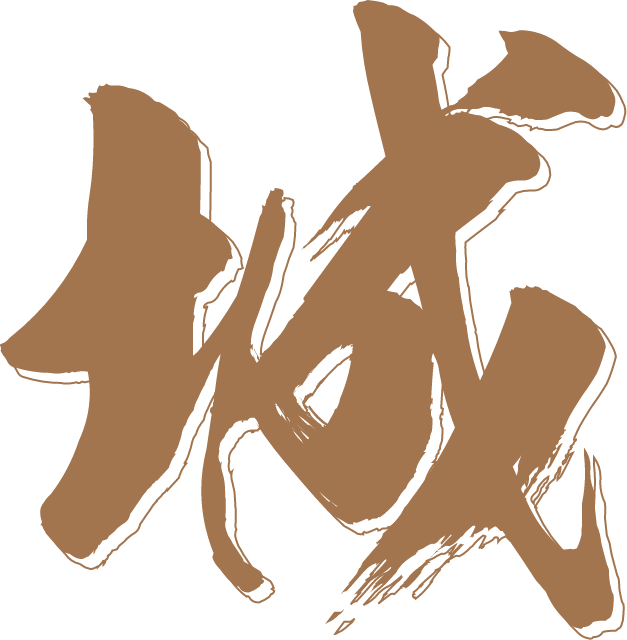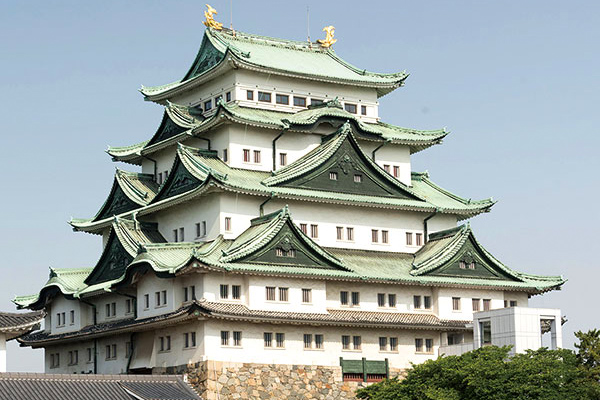Castles
Travel back in time to Japan in the Middle Ages
The Central Japan region is home to three castles designated as national treasures: Matsumoto Castle, Inuyama Castle, and Hikone Castle. The original keeps of these castles remain intact, preserved for hundreds of years. You can experience Japan’s past, going back in time over 400 years, in their historical castle town streets, as well as along the major roads which connected the cities of Tokyo and Kyoto at that time.
Matsumoto
Castle
[Nagano Prefecture/Matsumoto City]
National Treasure

Matsumoto Castle has the oldest existing five-tiered, six-story donjon in Japan. (designated as a National Treasure). With the faraway Japan Alps rising in the background, the castle provides spectacular views.
- An approx. 20-minute walk from Matsumoto Station on the JR Shinonoi Line
- Opening hours: 8:30–17:00 (Last entry16:30) *Varies according to the season
- Admission fees: Adults 700 yen / Elementary and Junior High School Students 300 yen
Moon-viewing Pavilion
The Moon-viewing Pavilion was constructed for the entertainment of the Shogun whenever he visited. The building is not armed because it was constructed during a time of peace.

Enjoy the Tonosama-Gozen traditional Japanese meal set at the Biwa-no-Yu hot springs, maintained by Matsumoto Castle
Traditional Japanese Restaurant Sousouan (in Biwa-no-Yu)

- Opening hours (Daytime) 11:30–14:30 / (Nighttime) 17:30–20:00
- Tonosama-Gozen
Enjoy a rickshaw ride around the castle town of Matsumoto
Why not take a traditional Japanese rickshaw ride around the castle town of Matsumoto?! Your rickshaw runner will point out the local sights as he pulls you around town.

Matsumoto Rickshaw Association
TEL: 080-4806-8177 (Koizumi)
- Operating hours: 9:30–16:30
- Regular holiday: Tuesday
Matsumoto Nawate-dori Shopping Street
Located 5 minutes’ walk from Matsumoto Castle, Matsumoto Nawate-dori Shopping Street is lined with unique shops in nagaya row-house-style buildings. The olden-time streetscape has been recreated, enabling visitors to experience a retro atmosphere.
Inuyama
Castle
[Aichi Prefecture/Inuyama City]
National Treasure

Built in 1537, the castle’s donjon is the oldest of its style remaining in Japan today. The view from the top floor of the donjon—built on top of a hill near a river—is truly superb. Below the castle lies the old-time streetscape of the castle town.
- An approx. 15-minute walk from the West Exit of Meitetsu Inuyama-Yuen Station
- Opening hours: 9:00–17:00 (Last entry: 16:30)
- Admission fees: Adults 550 yen / Elementary and Junior High School Students 110 yen
Views from the topmost floor
Go out onto the balcony to enjoy a spectacular 360° panoramic view of the Inuyama cityscape and flow of the Kiso River.

Take a stroll around the castle town wearing kimono
How about taking a stroll around the castle town wearing a traditional Japanese kimono? Undergarments and geta clogs are included in the rental plan, so you can simply come as you are!

Sanko Inari Shrine
Popular heart-shaped votive tablets
This shrine is located at the foot of the mountain on which Inuyama Castle stands. The pink heart-shaped votive tablets are tremendously popular among women!

Located at the foot of Shiroyama mountain, Sanko Inari Shrine is a shrine with a long history. Inuyama Castle is located at the top of the mountain, and the shrine also sees bustling crowds of visitors who have been sightseeing at the castle. The shrine’s adorably pink heart-shaped votive tablets are highly popular with among women visitors.

Showa Yokocho, Inuyama Castle Town
Located to the south of Inuyama Castle, the castle town retains a retro Showa-era (1926–1989) streetscape. With numerous nostalgic restaurants and souvenir shops lining the streets, visitors can also enjoy taking an “eating tour”.

Kuraya Tea Shop
This tea shop is located at the entrance to the Showa-Yokocho shopping district in Inyama Castle Town. The menu contains many menu items that are cute and colorful to the eye, earning the shop a large fan base comprising mainly women.

Hikone
Castle
[Shiga Prefecture/Hikone City]
National Treasure

This three-tiered, three-story flatland-hilltop castle was built 400 years ago on the orders of Tokugawa Ieyasu. The interior of the existing donjon is said to have been preserved in the best condition of any remaining castle donjon in Japan.
- An approx. 15-minute walk from JR Hikone Station
- Opening hours: 8:30–17:00
- Admission fees: Adults 800 yen Elementary and Junior High School students 200 yen
Largest number of gables of the 12 donjon existing today
Hikone Castle is characterized by it's beautiful appearance, created by the combination of Kirizuma-hafu, Irimoya-hafu, and Kara-hafu gables.

Enjoy a pleasure boat ride around the castle moat
Visitors to Hikone Castle can take pleasure boat rides around the castle moat. Enjoy the changing landscape in each season viewed from the boat.

- Boat ride tickets: Adults 1,300 yen / Children 600 yen
Nagoya
Castle
[Aichi Prefecture/Nagoya City]
Special Historic Site

Nagoya Castle is known as the “zenith of early modern castle design and construction”. After Tokugawa Ieyasu had the castle built in order to show his authority to the world, it proudly prospered as the residence of the Owari-Tokugawa family. (Currently, the donjon is out of order due to ongoing wooden restoration.)
- A 5-minute walk from Exit 7 of Nagoya jo (Nagoya Castle) Station on the Meijo Subway Line
- Opening hours: 9:00–16:30
- Nagoya Castle admission fees: Adults 500 yen / Junior High School Students and younger free of charge
Kiyomasa Stone
This is the largest stone in NagoyaCastle’s stone walls.

Kinshachi
There dazzling golden roof ornaments are Nagoya Castle’s symbols.

Honmaru Palace
reconstructed faithfully based on historical documents
Based on Edo Period (1603-1868) documents, survey maps draw up in the early 20th century, old photographs, and other historical documents, the Honmaru was authentically rebuilt over a period of 10 years, with reconstruction completed in 2018.
Chikurinhyoko-zu
The castle’s Entrance Hall is decorated with murals depicting a bamboo grove with leopards and tigers on a gold background.

Joraku-den
The Joraku-den was added as a place for the Shogun to rest when he visited and is the most gorgeously decorated room in the Honmaru Palace. In addition to the fusuma-e (sliding door paintings) and tenjoita-e (ceiling panel paintings), also note the intricately lavish decorations.

Okazaki
Castle
[Aichi Prefecture/Okazaki City]

This is the castle where Tokugawa Ieyasu was born. The donjon was reconstructed 60 years ago and now houses a museum.
- An approx. 15-minute walk from Meitetsu Higashi-Okazaki Station
- Opening hours: 9:00–17:00 (Last entry 16:30)
- Admission fees: Adults 200 yen / Children 100 yen
Daiju-ji Temple
Daiju-ji Temple is the only temple in Japan where life-sized memorial tablets for successive shoguns of the Tokugawa Shogunate are enshrined. The view of Okazaki Castle seen from Daiju-ji Temple is like a framed picture. Designated as National Important Cultural Properties, the paintings on the sliding doors in the Shogun Onari-no-Ma room, which only the Shogun was allowed to enter, are a must-see.

Vista Line
The Vista Line is an approx. 3 km straight view between Okazaki Castle and Daijuji Temple. Experience the historical view of Okazaki Castle through the gate of Daijuji Temple.

Kiyosu
Castle
[Aichi Prefecture/Kiyosu City]

In 1555, Lord Oda Nobunaga came from Nagoya Castle and took possession of Kiyosu Castle. In 1560, he was victorious in the Battle of Okehazama, launching his first move towards unifying Japan from Kiyosu Castle. Rebuilt in 1989, the current main tower of the castle has various exhibits and images introducing the history of Kiyosu for visitors to view.
Gifu
Castle
[Gifu Prefecture/Gifu City]

In 1567 (or 1564 by some accounts), Lord Oda Nobunaga captured this castle, then known as “”Inabayama Castle”, and took control of the surrounding region. Subsequently, he changed the name of the region to “Gifu”, and Gifu Castle became his main base for unifying Japan. The current castle structure was rebuilt in 1956, and it is possible to travel by ropeway to the Castle Tower on the top of Mt. Kinka.
Ogaki
Castle
[Gifu Prefecture/Ogaki City]

Featuring a four-story tower—a rarity among Japanese castles—Ogaki Castle was the site of a heroic battle during the Battle of Sekigahara in 1600. The current castle structure was rebuilt in 1959 after the original was razed to the ground during WWII.
Gujo Hachiman
Castle
[Gifu Prefecture/Gujo City]

Built as a fortress in 1559, at the end of the Warring States Period, Gujo Hachiman Castle is a popular mountain-top castle providing sweeping views of the castle town below. Here you can also experience nature’s four seasons, and the castle grounds are a popular walking course. It is also one of Japan's few castles in the clouds. Early morning only on misty days late in the year the castle appears as though it is floating among the clouds.
Gujo Hachiman Castle Town
Located at the foot of the Gujo Hachiman Castle, this castle town preserves the streetscape of the Edo Period. A waterway gushes past the old houses lining its banks, and the atmosphere conveys a sense of the local lifestyle, which has remained unchanged since Edo times. Gujo Hachiman Castle Town is famous for the area’s cool, clear water, represented by sogisui, and the Gujo Odori dance festival, which takes place in summer.

Iwamura
Castle
[Gifu Prefecture/Ena City]

Iwamura Castle was a virtually impregnable mountaintop castle built at an altitude of 717 m and utilizing to advantage the steepness of the mountain, which has a difference in elevation of 180 m, as a natural defense. The often-misty climate was also used to advantage in building the castle, which was also referred to as “Misty Castle”. Constructed around 1221, the castle has a long history, and today visitors can view the ruins of Iwamura Castle, including magnificent six-level stone walls.
Iwamura Castle Ruins
Retaining a historical and cultural appearance and streetscape, this castle town is characterized by scenery that cannot be seen anywhere else, such as a masugata (a square enclosure with two gates at right angles to each other to prevent direct entry and provide protection) and a canal flowing through the town. Around the approx. 1.3 km-long historical streetscape there are old homes and merchant houses retaining vestiges of Edo times, and traditional namako walls (featuring a white grid pattern on black slate) still remain today. The town is dotted with shops selling famous local delicacies such as Castella sponge cakes, Gohei-mochi rice cakes, and Kankara-mochi rice cakes, as well as breweries making local sake wines, making this the perfect place for an “eating tour”.

Naegi
Castle Ruins
[Gifu Prefecture/Nakatsugawa City]

Naegi Castle was built on Shiroyama mountain (432 m), soaring over the right bank of the Kiso River, which flows east-west through the center of Nagatsugawa City in Gifu Prefecture. Said to be unusual among Japanese castes, the stone walls of Naegi Castle incorporated enormous naturally occurring boulders. The lookout constructed on the ruins of the castle tower provide spectacular sweeping 360 degree views of Mt. Ena, the Kiso River, and the towns below.
Takato
Castle Ruins
[Nagano Prefecture/Ina City]

Takato Castle is one of Japan's Top 100 Castles and the former castle of Takeda, a warlord who fought against Oda Nobunaga. Today the site is famous as one of Japan's top cherry blossom views spots. The variety of cherry blossom is unique and known as Takatohiganzakura, with somewhat small red flowers. In the cherry blossom season, the entire castle is dyed pink, and the Kohiganzakura, that bloom in unison, is said to be the most beautiful in all the world.
Iga-Ueno
Castle
[Mie Prefecture/Iga City]

Iga-Ueno Castle was built in 1585 and renovated later by the master castle builder Takatora Todo. It is known as Hakuho (White Phoenix) Castle because of its stunning three-story white castle walls, which resemble a phoenix resting on its wings. Iga-Ueno Castle's stone walls are among the tallest in Japan. Today, the castle and its surrounding area, Ueno Park, are popular sightseeing spots in Iga-Ueno and are home to the Basho Memorial Museum and the Iga-ryu Ninja Museum.

